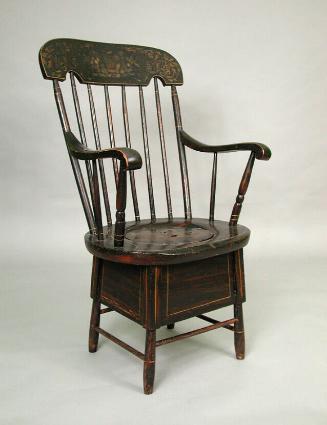Folding Chair
Furniture MakerMade by
B. J. Harrison Son Company
(American, founded 1840)
Date1850-1910
MediumMaple, wool Brussels carpet, metal
DimensionsPrimary Dimensions (overall height x width x depth): 30 5/8 x 16 1/2 x 21in. (77.8 x 41.9 x 53.3cm)
ClassificationsFurniture
Credit LineGift of Christine Bobbish
Object number1996.138.0
DescriptionBlack painted folding chair in the Empire, or late neoclassical, style, with a Brussels carpet seat. The back of the chair is formed by a crest rail with curved sides, atop two baluster-turned posts. The posts extend down through a thick horizontal seat rail to a turned rail. The seat consists of a single rectangular panel of red and black Brussels carpet with black stitching at either side. The carpet is inserted into the back seat rail, and wraps around the front seat rail. The chair has two pairs of crossed legs that meet in the center of each side and pivot on a cylindrical hinge pin. One set is joined to the front seat rail; a plain, turned stretcher connects the lower legs. The other set of legs, located outside of the others, are joined to the back seat rail and extend forward. The wooden elements of the chair are all painted black.
Condition: The black paint is flaking over all the wooden surfaces of the chair, but specifically on the front sides of the crest rail, the back left post, the top of the inner right leg. The carpet is disintegrating at the back, where it extends into the back seat rail.
Design and Construction Details: The crest rail is secured to the front of each post with two metal screws. The posts are tenoned through the back seat rail, which consists of a horizontal rail with a separate strip of wood screwed to the underside of the rail. The posts continue down and are tenoned into a turned rail. The Brussels carpet is inserted into the back seat rail through the top rail and the strip of wood below; the strip of wood is wrapped in fabric tape which is painted black. The carpet is wrapped around the cylindrical front seat rail and is inserted into a groove in the lower front of the rail. The front seat rail is cylindrical, and is tenoned into the top of the one pair of legs. A thin metal rod inserted across the front of the seat rail and into the leg at either end also helps to secure the carpet to the front seat rail. The stretcher joins the bottom of these two legs that are joined to the front seat rail. The second set of legs is joined to the back seat rail and to the center of the first set of legs with a round hinge pin. When the chair is folded or unfolded, the legs and back rail pivot on the hinge pins and on the back of the carpet seat. When open, the turned rail below the back seat rail hits the top of the legs, thus preventing the chair from opening further.
Condition: The black paint is flaking over all the wooden surfaces of the chair, but specifically on the front sides of the crest rail, the back left post, the top of the inner right leg. The carpet is disintegrating at the back, where it extends into the back seat rail.
Design and Construction Details: The crest rail is secured to the front of each post with two metal screws. The posts are tenoned through the back seat rail, which consists of a horizontal rail with a separate strip of wood screwed to the underside of the rail. The posts continue down and are tenoned into a turned rail. The Brussels carpet is inserted into the back seat rail through the top rail and the strip of wood below; the strip of wood is wrapped in fabric tape which is painted black. The carpet is wrapped around the cylindrical front seat rail and is inserted into a groove in the lower front of the rail. The front seat rail is cylindrical, and is tenoned into the top of the one pair of legs. A thin metal rod inserted across the front of the seat rail and into the leg at either end also helps to secure the carpet to the front seat rail. The stretcher joins the bottom of these two legs that are joined to the front seat rail. The second set of legs is joined to the back seat rail and to the center of the first set of legs with a round hinge pin. When the chair is folded or unfolded, the legs and back rail pivot on the hinge pins and on the back of the carpet seat. When open, the turned rail below the back seat rail hits the top of the legs, thus preventing the chair from opening further.
Status
Not on view












